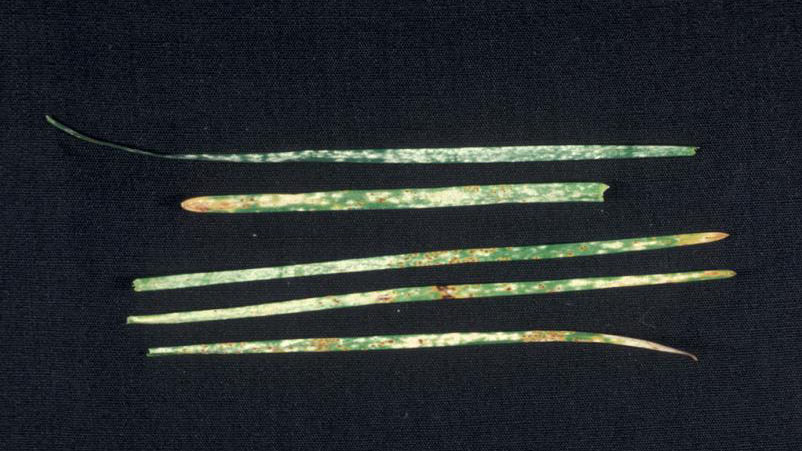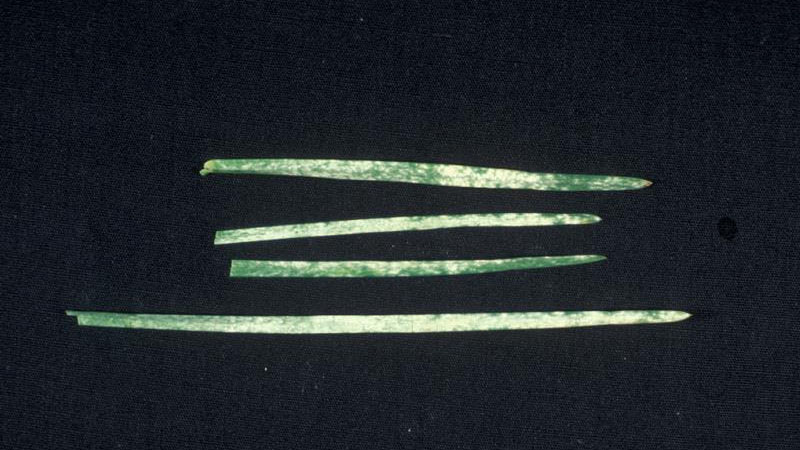Symptoms
The symptoms of powdery mildew are typically most severe in heavily shaded areas. In the initial stages of disease development, a white or gray, powdery growth is evident on infected leaves. Heavily infected leaves turn yellow or red and die slowly. If left uncontrolled for several weeks, powdery mildew will cause significant thinning of the turf and may also increase its susceptibility to environmental stresses or other pests.
Development Factors
The fungus survives the winter in living plant tissue. Spores are produced in the spring and are spread to healthy tissue by wind. The spores germinate and infect leaves during cool, humid conditions in the spring and fall. Because sunlight inhibits growth of the powdery mildew fungus, turf that is growing in dense shade is most prone to the disease. Unlike most foliar diseases, leaf wetness is not required for development of powdery mildew, but high humidity is necessary.
Cultural Control
Planting shade-tolerant grasses, such as the fine fescues (hard fescue, chewings fescue, or red fescue), is one of the best means of preventing severe problems with powdery mildew. A mixture of Kentucky bluegrass in combination with tall fescue and a fine fescue is preferred.
Turf growing in shade uses less nitrogen, requires less water, and is less tolerant of low mowing. Management practices should be adjusted accordingly for shaded areas. Apply no more than 1 pound of nitrogen per 1,000 square feet at any one time. Maintain mowing height at approximately 3 inches to increase rooting and provide greater leaf surface for photosynthesis. Water deeply and infrequently to enhance rooting and reduce leaf wetness. Avoid light, frequent watering and do not irrigate just before sunset or after sunrise because this extends the leaf wetness period which favors disease development. Pruning, removal, or careful placement of trees and shrubs to increase light intensity and air movement will help control powdery mildew.
Chemical Control
Through the use of proper cultural practices, powdery mildew can be managed to acceptable levels without fungicides in most cases. Fungicides can be applied on a curative basis if an unacceptable amount of disease develops. Mapping affected areas for treatment will help to minimize fungicide use.
Species Data
- HOST SPECIES
- Kentucky bluegrass, fine fescue, perennial ryegrass
- MONTHS WITH SYMPTOMS
- April to September
- STAND SYMPTOMS
- irregular distribution across turf stand
- FOLIAR SYMPTOMS LOCATION / SHAPE
- FOLIAR SYMPTOMS COLOR
- white
- ROOT / CROWN SYMPTOMS
- none
- FUNGAL SIGNS
- powdery spore masses
Publication date: Nov. 14, 2017
Reviewed/Revised: Dec. 16, 2019
Recommendations for the use of agricultural chemicals are included in this publication as a convenience to the reader. The use of brand names and any mention or listing of commercial products or services in this publication does not imply endorsement by NC State University or N.C. A&T State University nor discrimination against similar products or services not mentioned. Individuals who use agricultural chemicals are responsible for ensuring that the intended use complies with current regulations and conforms to the product label. Be sure to obtain current information about usage regulations and examine a current product label before applying any chemical. For assistance, contact your local N.C. Cooperative Extension county center.
N.C. Cooperative Extension prohibits discrimination and harassment regardless of age, color, disability, family and marital status, gender identity, national origin, political beliefs, race, religion, sex (including pregnancy), sexual orientation and veteran status.



